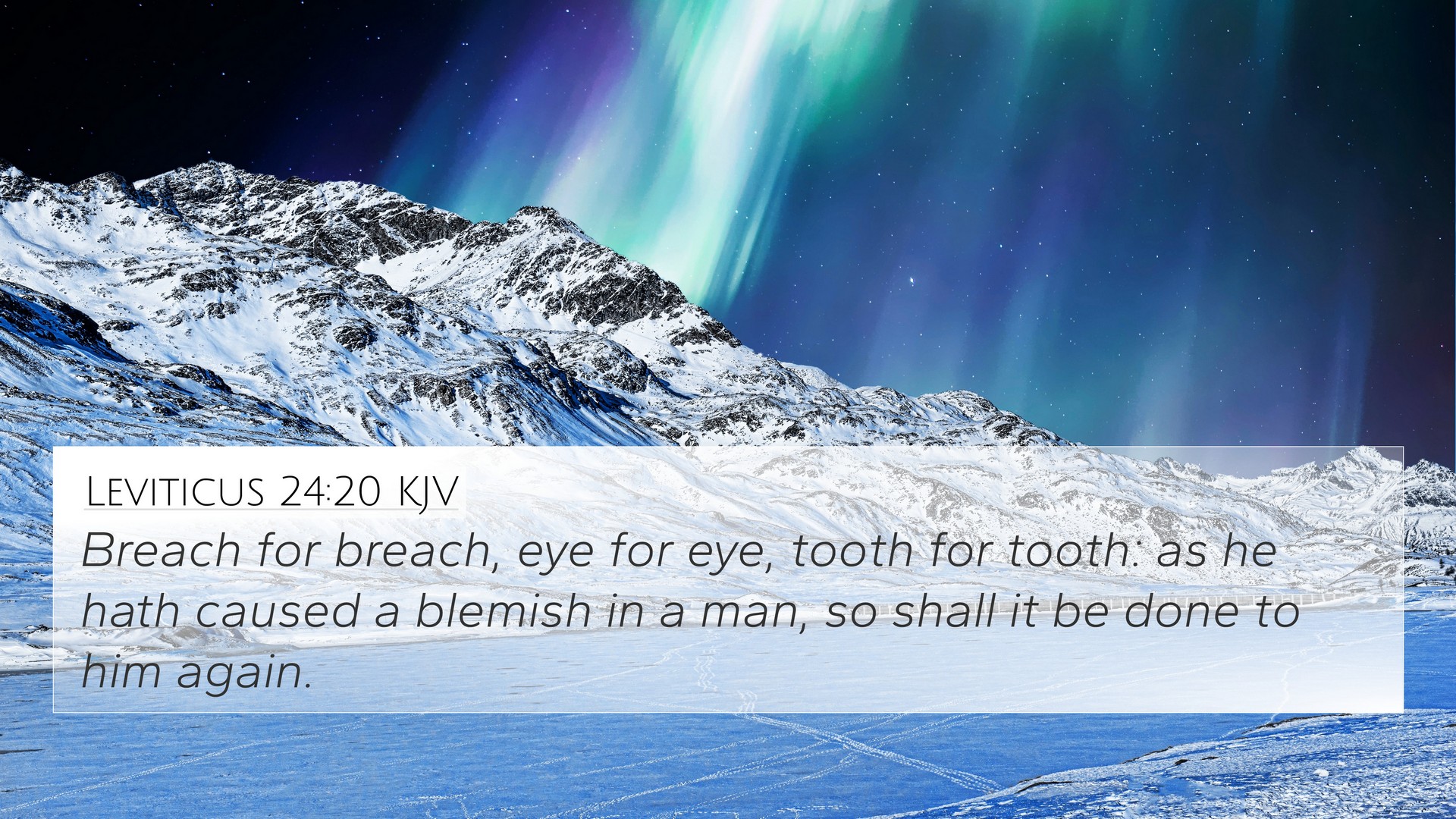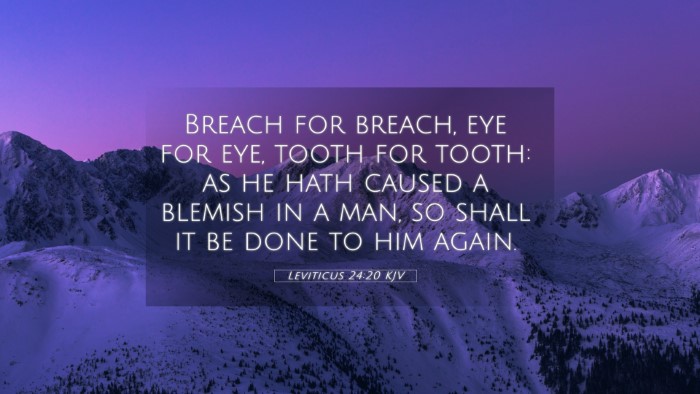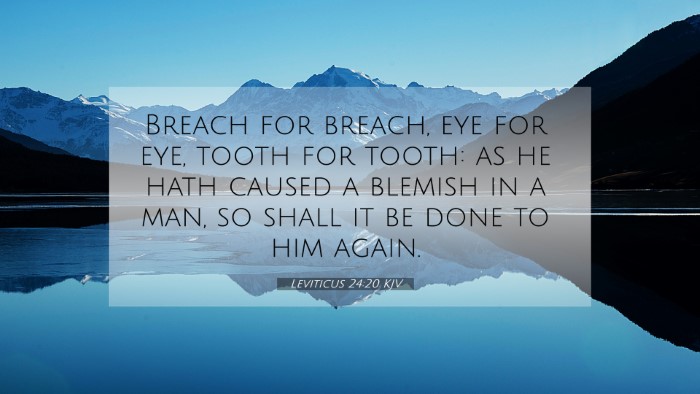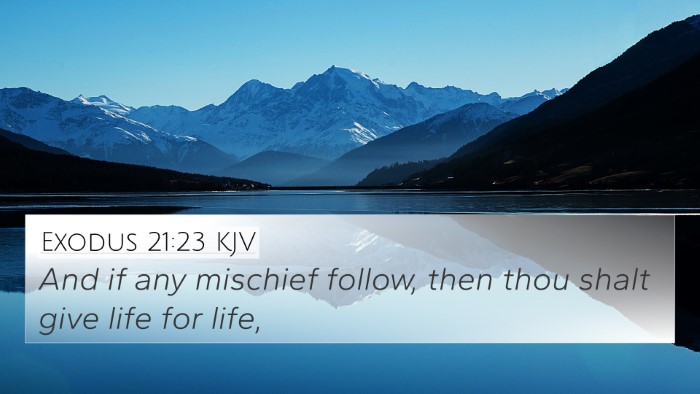Understanding Leviticus 24:20
Leviticus 24:20 states: "Breach for breach, eye for eye, tooth for tooth: as he hath caused a blemish in a man, so shall it be done to him again." This verse, often associated with the principle of retributive justice, calls for proportional punishment for wrongdoing. To delve deeper into its meaning, we can reference multiple commentaries and explore cross-references throughout Scripture.
Meaning and Interpretation
This verse encapsulates a significant biblical principle concerning justice and retribution. The context is found in the Law given to the Israelites and emphasizes both justice and mercy within the judicial system of ancient Israel.
Key Insights from Commentaries
-
Matthew Henry:
Henry emphasizes that the essence of this directive is to limit vengeance and prevent individuals from taking the law into their own hands. The principle of 'an eye for an eye' serves to delineate clear boundaries for justice, ensuring that retribution is not excessive.
-
Albert Barnes:
Barnes observes that this command serves as a foundational principle for civil law. It not only regulates the actions of individuals but also shows the need for fairness in governmental practices, preventing the escalation of personal vendettas.
-
Adam Clarke:
Clarke adds that this verse illustrates the seriousness of causing harm to another and reinforces the human dignity that must be upheld, indicating that justice should be restorative rather than solely punitive.
Cross-References
Understanding Leviticus 24:20 can be enriched by examining related Scriptures that provide additional context and insight. Here are some notable cross-references:
- Exodus 21:23-25: Similar principles of retribution are laid out in the context of bodily harm.
- Matthew 5:38-39: Jesus reinterprets this principle, teaching about responding to evil with good.
- Romans 12:19: Paul reinforces the idea that vengeance belongs to God, emphasizing mercy over retribution.
- Galatians 6:7: The principle of sowing and reaping reinforces the consequences of one's actions.
- Deuteronomy 19:21: This passage reiterates the need for equitable justice in similar terms.
- Proverbs 24:29: Advises against seeking revenge, echoing New Testament teachings on mercy.
- Luke 6:31: The Golden Rule as an antidote to the principle of retribution demonstrates a higher ethical standard.
Thematic Connections
This verse invites a deeper exploration into the themes of justice, mercy, and the societal implications of individual actions:
- Justice and Retribution: The balance between justice and mercy is a theme woven throughout Scripture, from the Old Testament laws to the New Testament teachings of Jesus.
- Human Dignity: The notion that each individual has inherent worth is a critical underpinning of legal systems that promote just treatment.
- Forgiveness vs. Revenge: The teaching of forgiveness in the New Testament contrasts sharply with the strictures of Old Testament law, providing a fuller picture of God’s heart toward humanity.
Tools for Bible Cross-Referencing
Engaging with Bible verses and their connections can enhance understanding and application. Consider using these tools:
- Bible Concordance: A reference tool that helps locate verses based on keywords.
- Bible Cross-Reference Guide: A resource that provides links between related Bible passages.
- Cross-Reference Bible Study: A method of studying where one verse leads to another, providing deeper insights into teachings.
Conclusion
Leviticus 24:20 serves as a powerful reminder of the principles of justice and the seriousness of our actions. Through cross-referencing, readers can discover interconnected truths that reveal God’s desire for righteousness and compassion in our social interactions. It opens the floor for a broader understanding of how these ancient teachings remain relevant in contemporary contexts.
FAQs on Bible Verse Cross-Referencing
- What verses are related to Leviticus 24:20?
Verses like Exodus 21:23-25 and Matthew 5:38-39 offer valuable insights into the principle of retribution.
- How do two specific Bible verses connect?
A cross-reference study method can illustrate the thematic connections between verses such as those in the Gospels and the Law.
- How to use Bible cross-references effectively?
Utilizing a concordance or cross-reference guide can help uncover the links and deeper meanings between passages.





